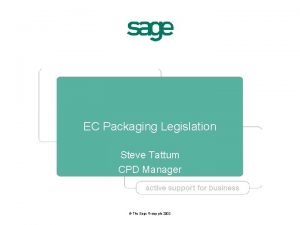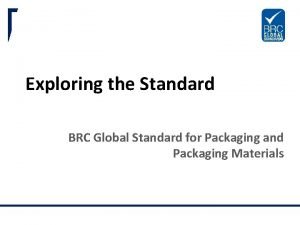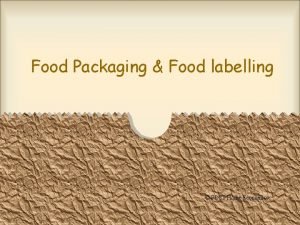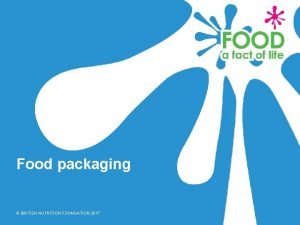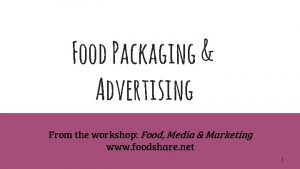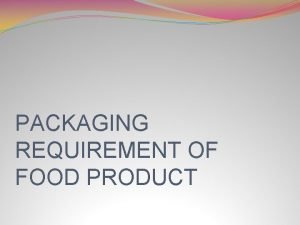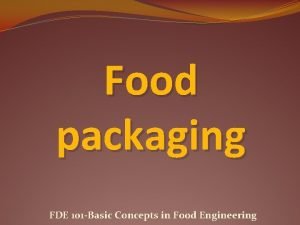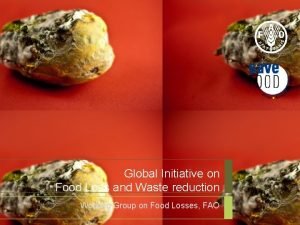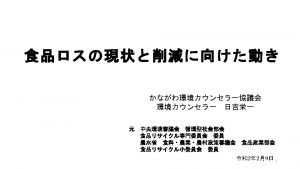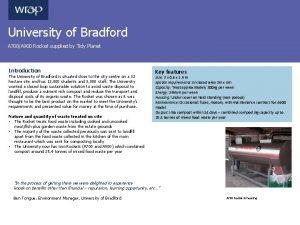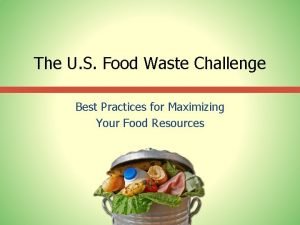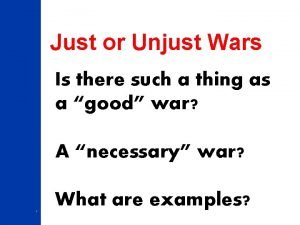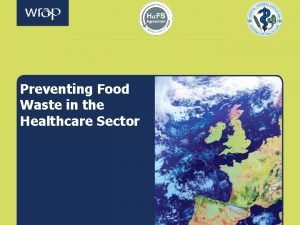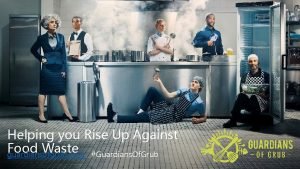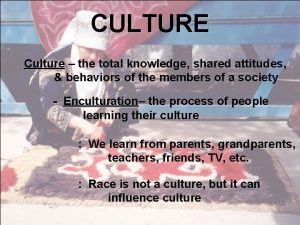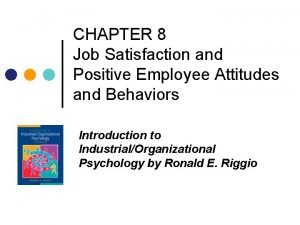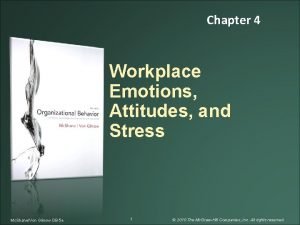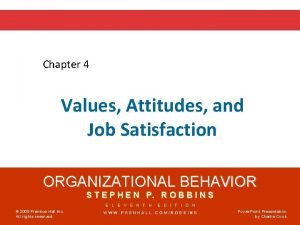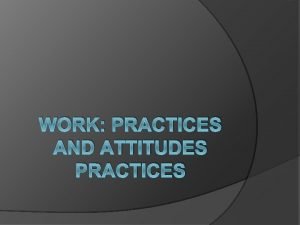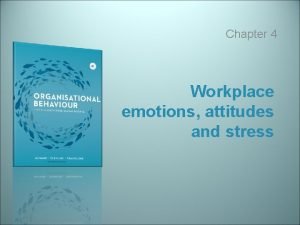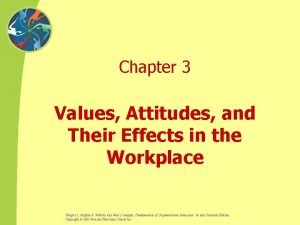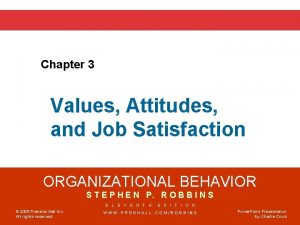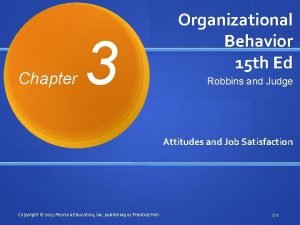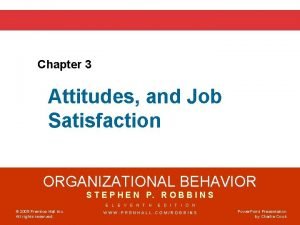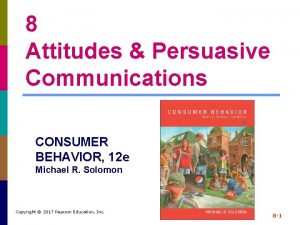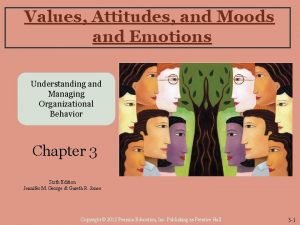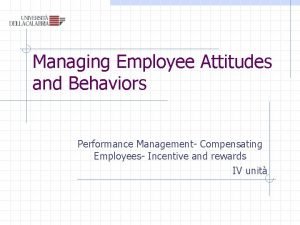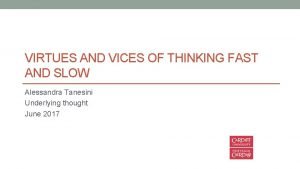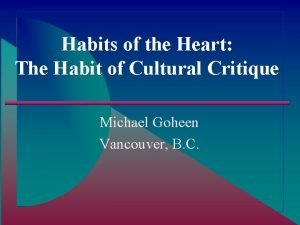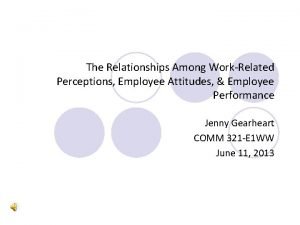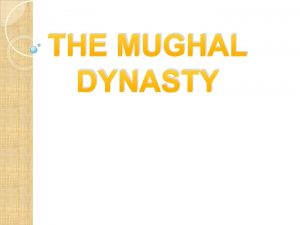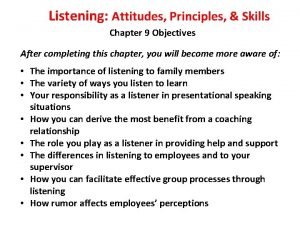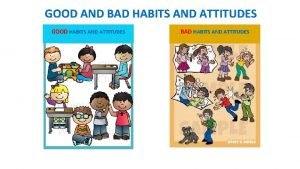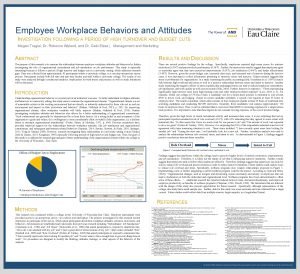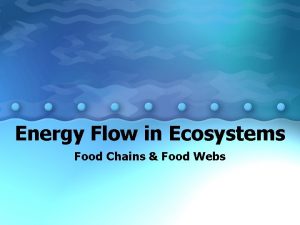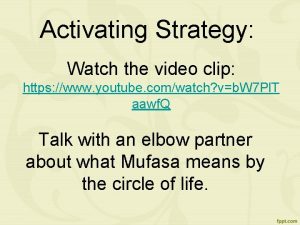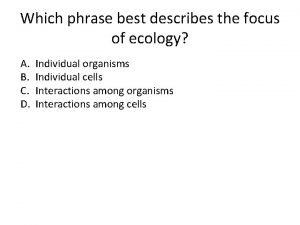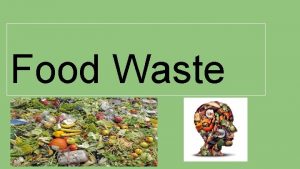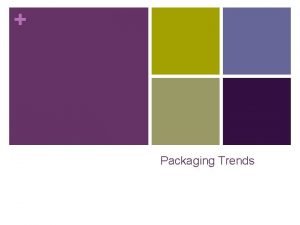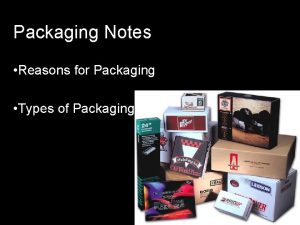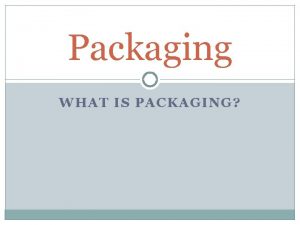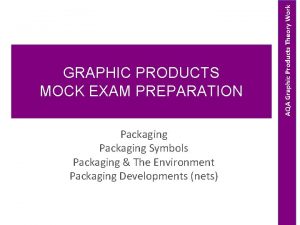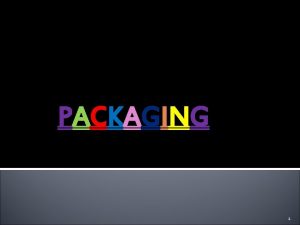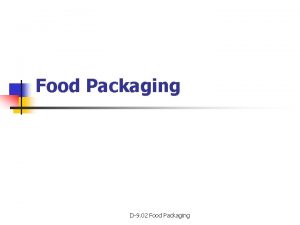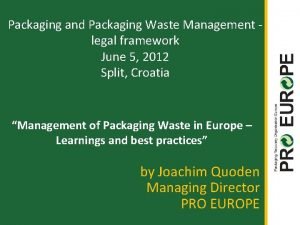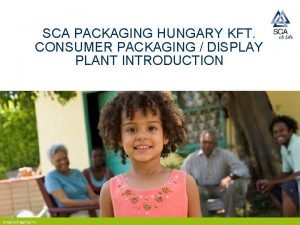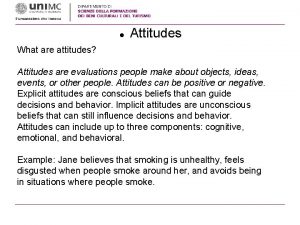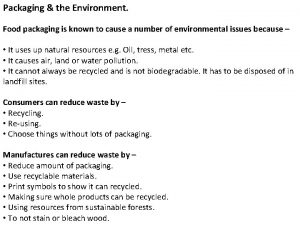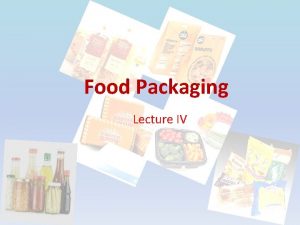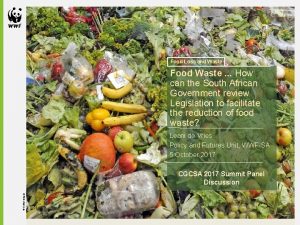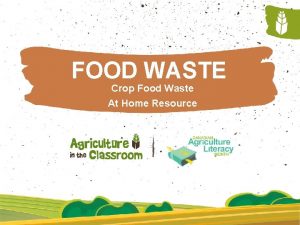Consumer attitudes to food waste and food packaging



























































- Slides: 59

Consumer attitudes to food waste and food packaging: Summary of research findings (March 2013) In partnership with:

Presentation outline n Background n Summary of key findings n Summary of opportunities n Examples of action n Methodology n Research findings n Overall summary n Need more?

Consumer attitudes to food waste and food packaging: Background

Why is this important? (1) ca. 60% of household food waste is from products ‘not used in time’, worth around £ 6. 7 billion a year n Most is from perishable / short shelf life products n – Incl. 17 billion ‘ 5 -a-day’ portions of fresh produce (more than a fifth of purchases) bought but not eaten n Previous research suggested that behaviours around packaging in home could be contributing to this – removing food from packaging after purchase but before storage (when the packaging is designed to keep the food fresher for longer) – not making use of packaging functionality (such as reclosing packs to prevent dehydration in the fridge) – not looking at or following guidance on pack (when to consume by, how to store, whether the product can be frozen)

Why is this important? (2) In addition, previous research, and feedback from engagement with consumers, suggested that attitudes towards packaging might be a barrier to further reducing the amount of food thrown away n However, there was a lack of robust evidence in this area to inform a strategy partners could implement to help address consumer concerns, and enable them to take steps to prevent food going to waste n n The insights from this new piece of research will help in the development of more effective messages and products that will enable consumers to get more from the food they buy, and make savings through wasting less

Who carried the research? n The research was commissioned by a Steering Group comprising representatives from – – – INCPEN (Industry Council for Packaging & the Environment) WRAP The Packaging Federation The Food & Drink Federation Kent Waste Partnership The British Retail Consortium WRAP co-funded the research, and had sign off on the research methodology and report n The research was undertaken by Icaro Consulting, between April and August 2012 n

What is different about this research? n Although much research has been carried out on food waste and food packaging, this new research has added significantly to our understanding, and our ability to help develop and deliver solutions to help consumers: – For the first time attitudes to food and packaging have been explored together in a broad range of contexts – The research has also revealed which factors around packaging are considered most helpful (in avoiding food waste) and also what consumers are aware of (which is new) – The large sample size in this study provides much more detail on different socio-demographics groups. This will help organisations develop more effective solutions for a wider range of consumers – The assessment of responses to different statements and messages around food waste and food packaging, via a methodology not used previously in this area will inform the development of more effective communications

Consumer attitudes to food waste and food packaging: Summary of key findings

Overall summary n n n Throwing away food “not used in time” is costing consumers £ 6. 7 billion a year (£ 270 for the average household) How long food stays fresh for is a priority for consumers Many are not making best use of the information on pack, or the packaging itself to achieve this Clear and consistent labelling (e. g. date labels, storage and freezing guidance), improved packaging functionality (e. g. re-closability, materials to enhance life) and communicating the benefits of using this will all make a difference Small changes in behaviour around packaging could deliver the benefits consumers are looking for – keeping food fresher for longer, saving money and reducing the impact of food on the environment

Key findings (headlines 1) n n n How long food lasts for, freshness and quality are priorities for consumers (in addition to price) Many consumers do not recognise that packaging protects food in the home Consumer confidence around storing food is high, but can be misplaced The information on labels, and how they are used, could both be more effective. There is demand for better on-pack guidance about storage and the majority of consumers say that they would use this Re-closable packs, packaging that makes the product last longer and split packs are rated as being most useful, but a gap exists in awareness of what products are available

Key findings (headlines 2) n n n In the wider context of food issues, only a small minority identify packaging as one of their top concerns When prompted, consumers are concerned about the environmental impact of packaging, but this is matched by concerns about the impact of food waste Concern about food waste increases in response to more information, whilst concern about packaging reduces Concern about packaging does not appear to be compromising action on food waste reduction There is recognition that food retailers and manufacturers have made progress to reduce the amount of packaging Being able to recycle packaging is important to consumers, and influences attitudes towards packaging

Consumer attitudes to food waste and food packaging: Summary of opportunities

Opportunities to help reduce food waste (1) As consumers we can all make more use of the information provided on packaging, particularly as much of this is being updated, and the packaging itself, to ensure that the way we store food at home keeps it fresher for longer n Local authorities, consumer groups and others can provide advice on buying food with the appropriate packaging (e. g. loose or packaged if you want to keep it fresher for longer), buying the right pack size and looking more closely at labels n Love Food Hate Waste is doing more to raise awareness of the benefits of reducing food waste, and the role that packaging can play in that. Further information about how to get involved can be found at our partners’ website n

Opportunities to help reduce food waste (2) n Food and packaging organisations (retailers, manufacturers, trade associations) should consider whether they, or their members, can do more to innovate their packaging or inform consumers about the innovations they are already making to raise awareness of the benefits and encourage consumers to make use of these n Continued innovation in packaging recyclability along with increased provision of recycling services, and clear communication on how to use them, has the potential to reduce concerns around packaging, helping consumers deal with packaging at the end of its life

Consumer attitudes to food waste and food packaging: Examples of action

Examples of action from the food industry Many more packs are now reclosable (e. g. cheese) n There a range of types of packs to suit different needs, (e. g. smaller packs of bread, ‘fridge packs’ for baked beans, ‘split packs’ so that you can use some now and some later) n Innovations to keep food fresher for longer, which means there is more time to eat the food whilst it is still at its best n Less confusing and more helpful labels: n – Retailers and brands are removing ‘display until’ dates so that the ‘best before’ and most importantly ‘use by’ dates are easier to see – More products have moved to a ‘best before’ date from a ‘use by’ date, giving the flexibility to use the product after the date – Most food packs have detailed storage advice, many are highlighting on the front of pack where to store food to keep it at its best – Retailers and brands are moving away from ‘freeze on day of purchase’ to ‘freeze before the date’, giving more time to freeze food

Examples of action




Consumer attitudes to food waste and food packaging: More detail on how the research was done, and the findings

Consumer attitudes to food waste and food packaging: Methodology

Methodology n Qualitative and quantitative methods were employed, comprising – a review of previous surveys on food waste and packaging – 18 accompanied food-shops and follow up in home depth interviews – an online survey of 4, 000 UK consumers (the largest to date on this subject) Quotas were set on age, gender, work status and geographic region to ensure that the sample was representative of the UK population WRAP co-funded the research, and had sign off on the research methodology and report n The research was undertaken by Icaro Consulting, between April and August 2012 n

Consumer attitudes to food waste and food packaging: Research findings

Insights n What is important to consumers? – Context is key n Are concerns about packaging getting in the way of tackling food waste? n How do messages about food waste and packaging influence attitudes?

What food issues concern consumers? % of people mentioning (average number of mentions = 4. 25

Factors influencing choice in store * * *

In an environmental context…. % giving that answer

In an environmental context…. % giving that answer

Needs and attitudes depend on context n n n How long food lasts for, freshness and quality are priorities for consumers (in addition to price) In a shopping context, packaging is a low priority, but plays a supporting and practical role in product choice When prompted, consumers are concerned about the environmental impact of packaging, but this is matched by concerns about the impact of food waste Concern about packaging does not appear to be compromising action on food waste reduction Those most concerned about packaging are indeed also those most concerned about food waste

Positive messages about packaging reduces concern

But attitudes are subject to change

Concerns about food waste increase with more information

Concerns about food waste increase with more information

Food waste vs packaging Concern about packaging does not appear to be compromising action on food waste reduction n Unlike previous surveys, that suggested packaging may be a far more pressing issue for consumers than food waste, this research finds that, when prompted, they consider both issues to be ‘equally problematic’ and do not have a fixed opinion as to which is ‘worse’ n However, consumers appear comfortable holding both views at the same time, and those most concerned about packaging are indeed also those most concerned about food waste n Concern about food waste increases in response to more information, whilst concern about packaging reduces in response to more information n

Insights n How food packaging is perceived and used

The perceived benefits of packaging

Beliefs about packaging Younger people, are far more inclined to agree with this statement (41% of 18 -34’s as opposed to just 16% of 55 -74’s)

% agreeing (strongly and tend to) Beliefs about packaging

Behaviour around packaging Store at home in original packaging Take out and use alternative wrapping Store in original packaging but ‘do’ something to it Take out of original packaging and store loose Apples Bananas Carrots

Confidence around food storage Overall, how confident are you that the way in which you store your fresh fruit and vegetables is the best way to ensure that they stay fresh for as long as possible?

Use of storage guidance % of people mentioning

Related WRAP research Do you have any tips for storing or improving shelf-life of fruit/veg? (WRAP, 2008) Storage and freezing (WRAP, 2007 -2012) n 24% store apples in the fridge (advice = keep refrigerated) n 70% store carrots in the fridge (advice = keep refrigerated) n 11% store bread in the fridge (advice = do not refrigerate) n 13% do not re-close packs of sliced meats after opening (advice = re-close to prevent drying out) n 59% believe pre-packed food should be frozen on the day of purchase (advice is now ‘freeze before the date’)

Those recognising the benefits of packaging have a more positive view

How food packaging is perceived and used n There is recognition that packaging is important to keep food safe on its way to, and in, the store, but less recognition that it plays a role at home n In fact, the prevailing view is the opposite, i. e. that keeping food in packaging leads it to spoil more quickly n This in turn leads many consumers to take food out of its packaging, which potentially decreases how long it lasts n The majority of consumers are confident in their way of storing food, and do not make use of guidance on pack n Among the minority of consumers who do recognise that packaging can keep products fresher for longer, attitudes to packaging are significantly less negative

Insights n Recognition innovations of, and demand for, packaging

What would consumers find most useful? % of people mentioning in their top 4

What would be most useful vs what has been noticed

How likely are consumers to use clearer labels? If there was clearer and more prominent information on the label about how to store the product in the most effective way/keep the item fresh for as long as possible, how likely would you be to use that information when you came to store food at home?

Likely use of labels – some examples % giving that answer

Packaging innovation n Re-closable packs, packaging that makes the product last longer and split packs are three of the innovations that consumers rated as being most useful to them n There is a noticeable gap between the amount of consumers who have seen particular packaging innovations and the number who say they would be a good idea n Re-closable packs are highlighted as being relatively prevalent in shops, but far fewer people have noticed ‘a lot’ of packaging that keeps food fresher or split packs n There is demand for better on-pack guidance about storage and the majority of consumers say that they would use this

Insights n What about end of life packaging?

Concern about packaging and perceived ease of recycling

What would be most useful vs what has been noticed

Packaging reduction - recognition of progress 90% say at least “a little” 46% a “fair amount” or more

Packaging recycling and reduction n n There is a strong correlation between concerns about packaging materials and how easy it is to recycle them When asked what changes in packaging consumers would find most useful, ‘recyclable – i. e. can be recycled’ was the second highest Levels of awareness of recyclable packaging was also high There is recognition of progress in recent years to reduce the amount of packaging (90% say at least “a little”; 46% a “fair amount” or more) Even those who consider packaging to be a major environmental problem acknowledge progress

Overall summary n n n Throwing away food “not used in time” is costing consumers £ 6. 7 billion a year (£ 270 for the average household) How long food stays fresh for is a priority for consumers Many are not making best use of the information on pack, or the packaging itself to achieve this Clear and consistent labelling (e. g. date labels, storage and freezing guidance), improved packaging functionality (e. g. re-closability, materials to enhance life) and communicating the benefits of using this will all make a difference Small changes in behaviour around packaging could deliver the benefits consumers are looking for – keeping food fresher for longer, saving money and reducing the impact of food on the environment

Consumer insights around packaging to prevent food waste: More information and materials are available

Need more? Full report, separate executive summary and short “Guide for Partners” can be found at: www. wrap. org. uk/fresherforlonger n A wide range of communications materials can be downloaded from the Love Food Hate Waste partners site, free of charge www. lovefoodhatewaste. com/partners n n For further details on the research contact: – andrew. parry@wrap. org. uk
 Steve tattum
Steve tattum Interpreting a food web
Interpreting a food web Brc global standard for packaging and packaging materials
Brc global standard for packaging and packaging materials Cashless philippines
Cashless philippines Introduction for biomedical waste management
Introduction for biomedical waste management Quality and design
Quality and design Black box model consumer behaviour
Black box model consumer behaviour Changes in an individual's behavior arising from experience
Changes in an individual's behavior arising from experience Desert herbivores
Desert herbivores Cengage
Cengage Consumer behaviour research process
Consumer behaviour research process Meaning of food packaging in home economics
Meaning of food packaging in home economics Objectives of food packaging
Objectives of food packaging Food packaging ads
Food packaging ads Functions of food packaging
Functions of food packaging What is active packaging
What is active packaging Food loss and waste
Food loss and waste Food loss and waste
Food loss and waste Food waste bradford
Food waste bradford 二戰英文
二戰英文 Food waste management software
Food waste management software Food is ammunition don't waste it meaning
Food is ammunition don't waste it meaning Food waste management system
Food waste management system Food waste management system
Food waste management system Food waste usa
Food waste usa Module 74 ap psychology
Module 74 ap psychology New zealand attitudes and values study
New zealand attitudes and values study Personal attitudes and dispositions also shape behavior
Personal attitudes and dispositions also shape behavior Quality culture vs traditional culture
Quality culture vs traditional culture Attitudes and movements
Attitudes and movements The total knowledge shared attitudes and behaviors
The total knowledge shared attitudes and behaviors Positive employee attitudes and behaviors
Positive employee attitudes and behaviors Workplace emotions attitudes and stress
Workplace emotions attitudes and stress Dominant work values in today's workforce
Dominant work values in today's workforce Work practices and attitudes
Work practices and attitudes Training is the act of increasing the
Training is the act of increasing the Workplace emotions, attitudes, and stress
Workplace emotions, attitudes, and stress Values and attitudes in the workplace
Values and attitudes in the workplace Values attitudes and job satisfaction
Values attitudes and job satisfaction Hazardous attitudes
Hazardous attitudes Communication is the exchange of
Communication is the exchange of Compare and contrast the major job attitudes
Compare and contrast the major job attitudes Organizational behavior chapter 3
Organizational behavior chapter 3 Attitudes and persuasive communications
Attitudes and persuasive communications Values attitudes moods and emotions
Values attitudes moods and emotions Managing employee attitudes and behaviors
Managing employee attitudes and behaviors Virtues and vices are attitudes. what are their objects?
Virtues and vices are attitudes. what are their objects? Hpliooshyp basic beliefs, concepts, and attitudes
Hpliooshyp basic beliefs, concepts, and attitudes Employee attitudes and employee performance
Employee attitudes and employee performance Mughal dynasty
Mughal dynasty Objectives of listening
Objectives of listening Habits and attitudes
Habits and attitudes Workplace behaviors and attitudes
Workplace behaviors and attitudes What are producers food web
What are producers food web Food chain consumer levels
Food chain consumer levels Study jams food chain
Study jams food chain Food chain consumer levels
Food chain consumer levels The term biomass refers to the total *
The term biomass refers to the total * Unit 2 food food food
Unit 2 food food food Food chain sequence
Food chain sequence
